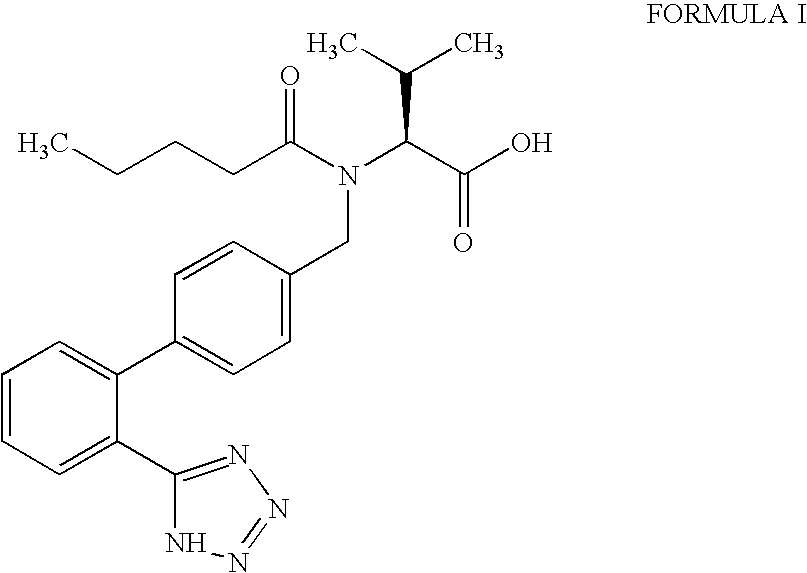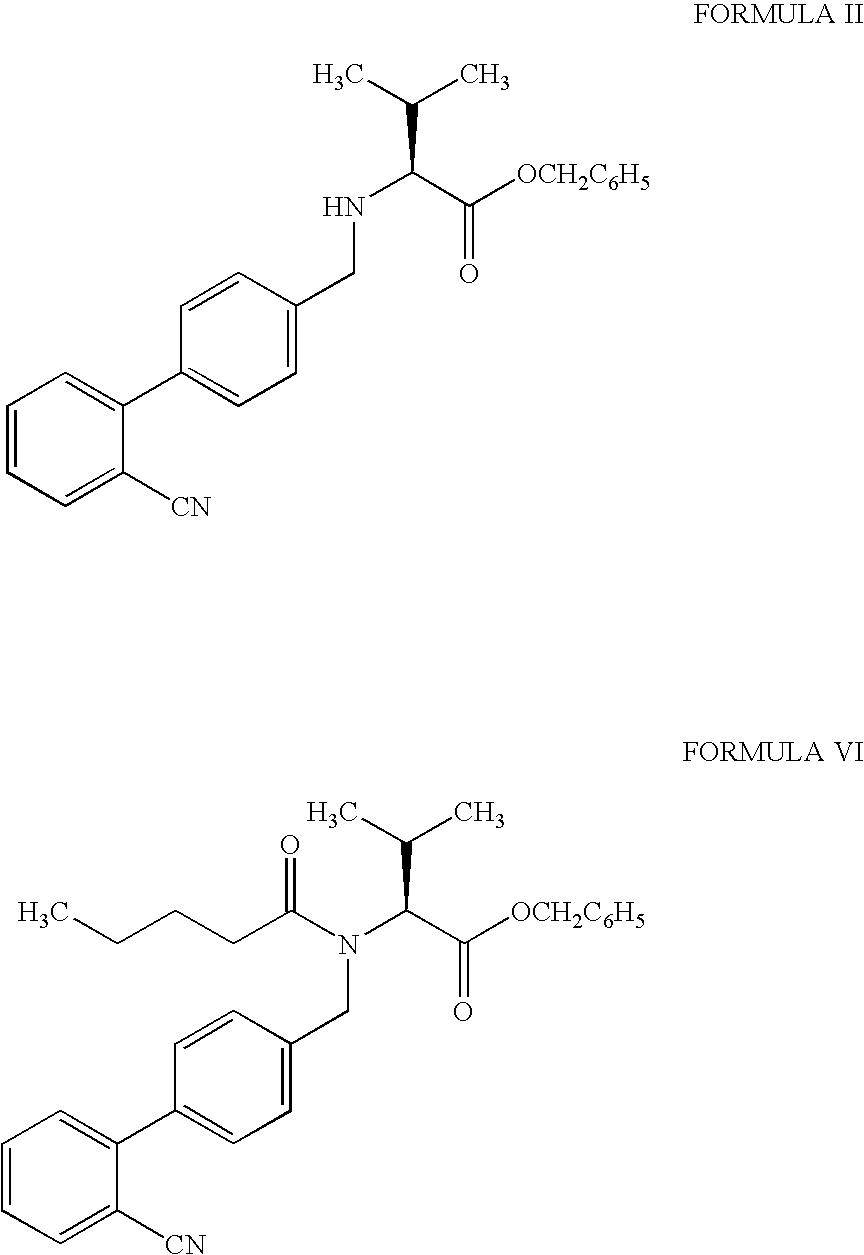Processes for the preparation of intermediates of valsartan
a technology of valsartan and intermediates, which is applied in the field of processes for the preparation of intermediates of valsartan, can solve the problems of long time, uneconomical, and product degradation, and achieve the effects of minimizing the chances of formation, and reducing the formation of byproducts
- Summary
- Abstract
- Description
- Claims
- Application Information
AI Technical Summary
Benefits of technology
Problems solved by technology
Method used
Image
Examples
example 1
Preparation of (S)—N-[(2′-cyanobiphenyl-4-yl)methyl]-(L)-valine benzyl ester hydrochloride
[0075]A mixture of potassium carbonate (152.2 g) and de-mineralized water (300 ml) was stirred for 10 to 15 minutes to dissolve the solid. The temperature of the mixture was maintained at 30° to 35° C. and dichloromethane (300 ml) was added. L-Valine benzyl ester tosylate (153.3 g), tetrabutyl ammonium bromide (10.0 g) and 4-bromomethyl-2′-cyanobiphenyl (100 g) were added to the reaction mixture. The reaction mixture was stirred for 20 to 24 hours at 30° to 35° C. After completion of the reaction de-mineralized water (400 ml) was added and the mixture was stirred for 5 minutes. The two phases were separated and the aqueous layer was extracted with dichloromethane (200 ml). The combined organic layer was washed with de-mineralized water (300 ml) and concentrated at 40° to 45° C. Ethyl acetate (600 ml) was then added to the residue and stirred for 5 to 10 minutes to dissolve the residue. The reac...
example 2
Preparation of (S)—N-[(2′-cyanobiphenyl-4-yl)methyl]-N-valeroyl-(L)-valine benzyl ester
[0078]A mixture of potassium carbonate (95.3 g) and de-mineralized water (100 ml) was stirred for 10 to 15 minutes to dissolve the solid. The temperature of the mixture was maintained at 25° to 30° C. and dichloromethane (300 ml) was added to the mixture. (S)—N-[(2′-Cyanobiphenyl-4-yl)methyl]-(L)-valine benzyl ester hydrochloride (100 g) and tetrabutyl ammonium bromide (10.0 g) were added to the mixture. The reaction mixture was cooled to −10° to −8° C. and valeryl chloride (36.1 g) was added at −10° to −5° C. The reaction mixture was stirred for 60 to 90 minutes at 0° to 5° C. After the completion of the reaction, the temperature was raised to 25° to 30° C. De-mineralized water (200 ml) was added to the reaction mixture and the mixture was stirred for 1 hour at 25° to 30° C. The two phases were separated and the organic layer was washed with de-mineralized water (200 ml). The organic layer was co...
example 3
Preparation of (S)—N-(1-benzyloxycarbonyl-2-methyl-prop-1-yl)-N-pentanoyl-N-[2′(1H-tetrazol-5-yl)biphenyl-4-yl-methyl]amine
[0079]A mixture of (S)—N-[(2′-cyanobiphenyl-4-yl)methyl]-N-valeroyl-(L)-valine benzyl ester as obtained in Example 2, tributyltin chloride (150 g), sodium azide (30 g) and tetrabutyl ammonium bromide (10 g) in toluene (200 ml) was refluxed for 30 hours. After the completion of the reaction, the reaction mixture was cooled and stirred with a solution of toluene (200 ml), de-mineralized water (400 ml) and acetic acid (60 ml) for 1 hour. The organic layer was separated, concentrated and dissolved in 1,4-dioxane (500 ml). The solution was cooled to 10° to 15° C. and stirred with a solution of sodium hydroxide (27.6 g in 690 ml of water) at 0° to 5° C. for 1 hour. The aqueous layer was extracted twice with diisopropylether, acidified and extracted with ethyl acetate. The ethyl acetate layer was concentrated at reduced pressure to obtain title compound as oil.
PUM
| Property | Measurement | Unit |
|---|---|---|
| temperature | aaaaa | aaaaa |
| temperature | aaaaa | aaaaa |
| temperature | aaaaa | aaaaa |
Abstract
Description
Claims
Application Information
 Login to View More
Login to View More - R&D
- Intellectual Property
- Life Sciences
- Materials
- Tech Scout
- Unparalleled Data Quality
- Higher Quality Content
- 60% Fewer Hallucinations
Browse by: Latest US Patents, China's latest patents, Technical Efficacy Thesaurus, Application Domain, Technology Topic, Popular Technical Reports.
© 2025 PatSnap. All rights reserved.Legal|Privacy policy|Modern Slavery Act Transparency Statement|Sitemap|About US| Contact US: help@patsnap.com



